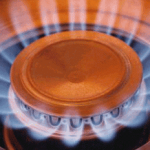 Natural gas futures fell on Wednesday ahead of Thursdays government supply report which is poised to show a much larger-than-average build in US natural gas inventories. Bearish short-term weather patterns kept the market pressured, but moves to the downside were limited by expectations for a decent warm-up starting this weekend.
Natural gas futures fell on Wednesday ahead of Thursdays government supply report which is poised to show a much larger-than-average build in US natural gas inventories. Bearish short-term weather patterns kept the market pressured, but moves to the downside were limited by expectations for a decent warm-up starting this weekend.
On the New York Mercantile Exchange, natural gas futures for settlement in September fell by 0.73% to $3.796 per million British thermal units by 11:50 GMT. The contract held in a daily range between $3.830 and $3.795, having fallen to an 8-1/2-month low of $3.725 on Monday. The energy source added 1.57% on Tuesday to close at $3.824, rising to positive weekly territory.
Despite the prospects of an upcoming warm-up, the market remained dominated by short-term bearish sentiment as the recent mild weather likely led to another much larger-than-average build in nationwide US inventories, due to be reported tomorrow.
According to NatGasWeather.coms July 30 – August 5 forecast, cooling demand on national level will be lower than normal as an unseasonably cool Canadian blast pushed deep into the South, bringing showers, thunderstorms and below-average temperatures. Reinforcing cool blasts will follow throughout the week, keeping electricity demand to power air conditioning low. A compact weather system will head through the southern Plains, bringing rainy and cooler conditions to the high-consuming state of Oklahoma. The western and southernmost areas of the country will remain hot, driving seasonably strong local demand, which however wont be enough to induce a significant change in power consumption on national level.
Large volatility will be seen on Thursday when the EIA is expected to report a yet another larger-than-average jump in nationwide stockpiles, with NatGasWeather.com market analysts expecting a build of 90-93 billion cubic feet, well above the average of 42 bcf.
For the time span between August 6 – August 12, NatGasWeather.com expects temperatures across the eastern, southern and western US to gradually warm-up into the 90s, setting the stage for stronger cooling demand and smaller inventory builds. However, temperature rises in the Midwest and Northeast will be kept in check by cooler weather systems tracking from southern Canada and although there will be a warm-up, readings will remain below the usual, suggesting lower-than-normal cooling demand.
Bearish sentiment not over yet
Moreover, bearish headwinds will persist for a bit more as the current weeks mostly mild weather will have a negative impact on August 7ths inventory report as well since it includes data for the seven days ended August 1st. However, as readings begin to track higher during the upcoming weekend, the following stockpile reports are expected to come much leaner and closer to the average, supporting price movements to the upside.
According to AccuWeather.com, the high in New York on August 2nd will be 76 degrees Fahrenheit, 8 below usual, before jumping to 85 degrees on August 6th, 1 above the average. In Chicago, readings will peak at 80 degrees on August 2nd, 3 beneath the normal, and will remain below seasonal through the end of August, apart from several single days with above-average temperatures.
To the South, Houston will see highs of 90-93 degrees through August 6th, 2-3 below normal, followed by a one-week period of even lower readings, which will then give way to above-seasonal readings reaching into the upper 90s between August 14th and August 19th. On the West Coast, the high in Los Angeles on August 2nd will be 88 degrees Fahrenheit, above the average of 84. Warmer-than-usual weather is projected to persist up to the last several days of August, with highs reaching as much as 92-93 degrees on August 12th and 13th, compared to normal readings of 84 degrees.
Technical view
According to Binary Tribune’s daily analysis, in case natural gas for settlement in September penetrates the first resistance level at $3.857 per million British thermal units, it will encounter next resistance at $3.890. If breached, upside movement will probably attempt to advance to $3.949 per mBtu.
If the energy source drops below its first resistance level at $3.765 per mBtu, it will see support at $3.706. If the second key support zone is breached, the power-station fuel’s downward movement may extend to $3.673 per mBtu.





